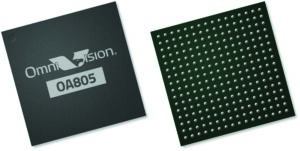 OmniVision Technologies, Inc. announced in advance of CES the OA805, a video processor that supports high-efficiency video coding (HEVC) compression with the lowest power consumption in the industry.
OmniVision Technologies, Inc. announced in advance of CES the OA805, a video processor that supports high-efficiency video coding (HEVC) compression with the lowest power consumption in the industry.
The interest in HEVC (also known as H.265) for IoT-enabled home security devices is growing rapidly. This advanced video compression standard reduces storage requirements and enables the streaming of 4K videos over wireless connections. The trade-off is that the compression routine is computationally intensive and can consume more power. The OA805, however, is extremely power efficient, and is making HEVC possible for battery-powered security cameras and video doorbells for the first time.
The OA805 has a boot-up time that is significantly faster than its nearest competitor. This rapid startup eliminates any delay between motion detection and video recording, potentially allowing the camera to instantly alert users of suspicious activities. Within 0.1 seconds (100 ms), the OA805 can go from completely powered off to fully functional. This also allows the OA805 to boot-up only at the moment when motion is detected in the security camera’s field of view, thus avoiding the need for a standby or sleep mode. Because the processor consumes no power when it is off, the overall power consumption of the security camera is extremely low and allows the camera to have up to two years of battery life.
The OA805 is a system-on-chip (SoC) that features dual embedded Arm® Cortex®-A5 CPU cores with Neon™ technology for accelerated audio and video encoding/decoding, along with image processing, video encoding hardware and RGB/IR processing. Its high dynamic range (HDR) processing capability allows the OA805 to accept input from RBG/IR image sensors and support high-quality displays, for videos taken during the day or at night, in conditions with widely contrasting bright and dark images.
As an upgrade from OmniVision’s OV798, the OA805 adds HEVC capability, consumes less power, boots up faster and offers higher resolution processing. This video processor accepts up to 16-megapixel captures from an image sensor and outputs up to 4K resolution video at 30 frames per second (fps) using HEVC encoding and decoding. It also supports multiple video streams at lower resolution, including H.264 1080p resolution at 60fps, as well as HDR and RGB-IR.

Well written Aimee